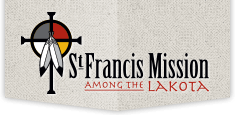St. Francis Mission facts for kids

Lakota Chief Spotted Tail
requested Jesuit educators |
|
| Established | 1886 |
|---|---|
| Location |
|
|
Board of
Directors |
President Fr. John Hatcher, S.J. |
|
Area
|
34 acres (14 ha) |
| Affiliations | Jesuit, Catholic |
| Website | SF Mission |
|
St. Francis Mission
|
|

St. Charles Borromeo Catholic Church
|
|
| Location | Rosebud Indian Reservation |
|---|---|
| NRHP reference No. | 75001723 |
| Added to NRHP | June 20, 1975 |
St. Francis Mission is a Roman Catholic mission located on the Rosebud Indian Reservation in St. Francis, South Dakota. It serves the Lakota, a Native American people also known as the Sioux. The mission was started in 1886 by Jesuit priests. They were welcomed by the Lakota and the local Catholic bishop.
The mission grew into a large complex of buildings. A big fire in 1916 destroyed most of them, but many were rebuilt. Today, the mission has 26 buildings. The most famous are the St. Charles Borromeo Church and Drexel Hall. The mission is also home to a special statue of Kateri Tekakwitha, a Native American saint.
Because of its important history, the mission was added to the National Register of Historic Places in 1975. This is a list of special places in the United States that are worth protecting.
Contents
History of the Mission
A Welcome from Lakota Leaders
In the 1840s, a Jesuit priest named Father Peter DeSmet visited the area. The Lakota people trusted him. Because of this, two important Lakota leaders, Chief Sinte Gleska (Spotted Tail) and Chief Red Cloud, asked for more Catholic priests to come.
In 1877, they asked President Rutherford B. Hayes for permission to bring "those who wear black dresses." They were talking about the Jesuits, who were known for their black robes and for being great teachers. The chiefs wanted the priests to teach their people how to read and write English.
Building the Mission
The first Jesuits arrived around 1882. With money from a kind woman named St. Katherine Drexel, they built a large school building by 1886. In 1888, three Franciscan Sisters came to teach at the school. They named it St. Francis School, after St. Francis.
A Jesuit priest, Father Florentine Digmann, worked closely with the Lakota. He helped start 37 small churches, called chapels, all across the Rosebud Reservation. Since 1974, the Lakota tribe has run the school, which they call Sapa Un Ti. This means "where the Black Robes live" in the Lakota language.
Programs at the Mission Today
Today, Jesuit priests and volunteers continue to work at the mission. They serve about 20,000 Lakota people on the reservation. The mission offers many programs to help the community.
Sapa Un Catholic Academy
This school opened in 2013. It teaches students from kindergarten to 5th grade in both English and the Lakota language. The school's goal is to help more Lakota students go to college and become leaders. It is open to students of all religions and offers scholarships to help families with the cost.
Lakota Studies
This program works to save the Lakota language and culture. Deacon Ben Black Bear, Jr. is translating the New Testament of the Bible into the Lakota language. The program also created a new Lakota dictionary in 2008 to help people learn the language.
Family Wellness
The mission offers a program to help families work through challenges together. It provides support for families facing difficult situations. Trained staff lead the program in different communities on the reservation each month.
Community Support and Hope
Life can sometimes be very hard, and people can feel sad or hopeless. The mission provides a crisis hotline that is open 24 hours a day, 7 days a week. Anyone who needs to talk to someone can call this number for help and support.
KINI 96.1 FM Radio
The mission runs a radio station called KINI 96.1 FM. It broadcasts news, weather, music, and local sports to people in South Dakota and Nebraska. The station also shares religious and educational programs. It reaches over 20,000 listeners.
Buechel Memorial Lakota Museum
This museum is named after Father Eugene Buechel, a priest and scholar who lived at the mission for over 50 years. He studied the Lakota language and culture. The museum has over 2,000 items and 42,000 photos that show the history and traditions of the Lakota people.
See also
- " Inculturation project", St. Francis Mission, May 2015
- National Register of Historic Places listings in Todd County, South Dakota


